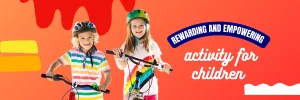Bike riding is a wonderful way for children to enjoy the outdoors, improve their physical fitness, and develop coordination and balance. For children with disabilities, biking can also foster independence and boost self-esteem. If you are considering introducing your little one to cycling, here are some helpful tips to ensure a safe and enjoyable experience.

1. Choose the Right Bike
Selecting the appropriate bike is crucial for a positive riding experience. Consider the following options:
- Adaptive Bikes: These are specifically designed for children with disabilities, providing various features like extra stability, harnesses, or customised seating to accommodate specific needs.
- Tricycles: For those who may struggle with balance, tricycles offer more stability than traditional bicycles.
- Tag-Along Bikes: If your child is ready to learn but still needs some support, a tag-along bike allows them to pedal alongside you while you maintain control.
- Bike Size: Ensure the bike is the right size for your child. They should be able to comfortably reach the pedals and the handlebars while maintaining a proper riding posture.
2. Safety Gear is Essential
Safety should always come first. Equip your child with the following gear:
- Helmet: A properly fitting helmet is vital to protect your child’s head. Make sure it meets safety standards and is adjusted correctly.
- Protective Pads: Wrist guards, knee pads, and elbow pads can help prevent injuries from falls.
- Reflective Gear: If riding in low light, consider reflective clothing or bike accessories to enhance visibility.
3. Find the Right Environment
Choose a safe, welcoming environment for your child to practice riding:
- Flat, Open Spaces: Start in a flat, open area, such as a park or empty parking lot, where your child can practice without obstacles or traffic.
- Avoid Busy Roads: Stay away from busy streets and areas with heavy traffic until your child is more confident and skilled at riding.
4. Start with Basic Skills
Before hitting the road, help your child develop foundational biking skills:
- Balance Exercises: If your child is new to cycling, practice balance exercises on a stationary bike or a balance bike without pedals.
- Pedalling Practice: Introduce the concept of pedalling in a controlled setting, encouraging them to push the pedals while maintaining balance.
- Braking: Teach your child how to use the brakes effectively to stop safely.
5. Use Positive Reinforcement
Encourage and motivate your child throughout the learning process:
- Celebrate Achievements: Celebrate small milestones, whether it is balancing for a few seconds longer or successfully pedalling a short distance.
- Be Patient: Learning to ride can take time. Be patient and supportive, allowing your child to progress at their own pace.
- Make it Fun: Incorporate games or challenges into practice sessions to keep the experience enjoyable.
6. Consider Riding Together
Riding alongside your child can enhance their experience:
- Tag Along: Use a tag-along bike or ride your own bike while they practice, offering guidance and support.
- Family Rides: Organise family bike rides to encourage inclusivity and make biking a fun, shared activity.
7. Explore Bike Trails
Once your child feels confident, consider exploring bike trails designed for cyclists of all abilities. These trails often offer a safe, enjoyable environment for riders to practice their skills and enjoy nature.
8. Seek Support from Organisations
Many organisations offer resources, adaptive bikes, and training programs for children with disabilities. Consider reaching out to local advocacy groups, rehabilitation centres, or adaptive sports programs to find additional support and equipment.

Conclusion
Bike riding can be a rewarding and empowering activity for children with disabilities. By choosing the right bike, ensuring safety, and providing a supportive environment, you can help your little one enjoy the thrill of cycling while building confidence and skills. Remember, the journey may take time, but with patience and encouragement, your child can experience the joy of riding a bike!
Published on October 4, 2024
